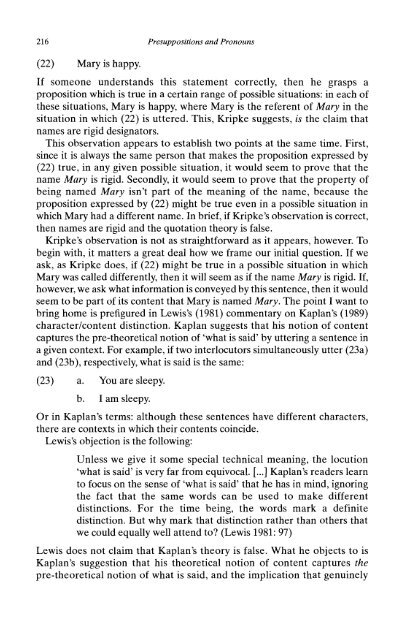Presuppositions and Pronouns - Nijmegen Centre for Semantics
Presuppositions and Pronouns - Nijmegen Centre for Semantics
Presuppositions and Pronouns - Nijmegen Centre for Semantics
You also want an ePaper? Increase the reach of your titles
YUMPU automatically turns print PDFs into web optimized ePapers that Google loves.
216 <strong>Presuppositions</strong> <strong>and</strong> <strong>Pronouns</strong><br />
(22) Mary is happy.<br />
If someone underst<strong>and</strong>s this statement correctly, then he grasps a<br />
proposition which is true in a certain range of possible situations: in each of<br />
these situations, Mary is happy, where Mary is the referent of Mary in the<br />
situation in which (22) is uttered. This, Kripke suggests, is the claim that<br />
names are rigid designators.<br />
This observation appears to establish two points at the same time. First,<br />
since it is always the same person that makes the proposition expressed by<br />
(22) true, in any given possible situation, it would seem to prove that the<br />
name Mary is rigid. Secondly, it would seem to prove that the property of<br />
being named Mary isn't part of the meaning of the name, because the<br />
proposition expressed by (22) might be true even in a possible situation in<br />
which Mary had a different name. In brief, if Kripke's observation is correct,<br />
then names are rigid <strong>and</strong> the quotation theory is false.<br />
Kripke's observation is not as straight<strong>for</strong>ward as it appears, however. To<br />
begin with, it matters a great deal how we frame our initial question. If we<br />
ask, as Kripke does, if (22) might be true in a possible situation in which<br />
Mary was called differently, then it will seem as if the name Mary is rigid. If,<br />
however, we ask what in<strong>for</strong>mation is conveyed by this sentence, then it would<br />
seem to be part of its content that Mary is named Mary. The point I want to<br />
bring home is prefigured in Lewis's (1981) commentary on Kaplan's (1989)<br />
character/content distinction. Kaplan suggests that his notion of content<br />
captures the pre-theoretical notion of 'what is said' by uttering a sentence in<br />
a given context. For example, if two interlocutors simultaneously utter (23a)<br />
<strong>and</strong> (23b), respectively, what is said is the same:<br />
(23) a. You are sleepy. sleepy,<br />
b. I am sleepy.<br />
Or in Kaplan's terms: although these sentences have different characters,<br />
there are contexts in which their contents coincide.<br />
Lewis's objection is the following:<br />
Unless we give it some special technical meaning, the locution<br />
'what is said' is very far from equivocal. [...] J Kaplan's readers learn<br />
to focus on the sense of 'what is said' that he has in mind, ignoring<br />
the fact that the same words can be used to make different<br />
distinctions. For the time being, the words mark a definite<br />
distinction. But why mark that distinction rather than others that<br />
we could equally well attend to (Lewis 1981: 97)<br />
Lewis does not claim that Kaplan's theory is false. What he objects to is<br />
Kaplan's suggestion that his theoretical notion of content captures the<br />
pre-theoretical notion of what is said, <strong>and</strong> the implication that genuinely














